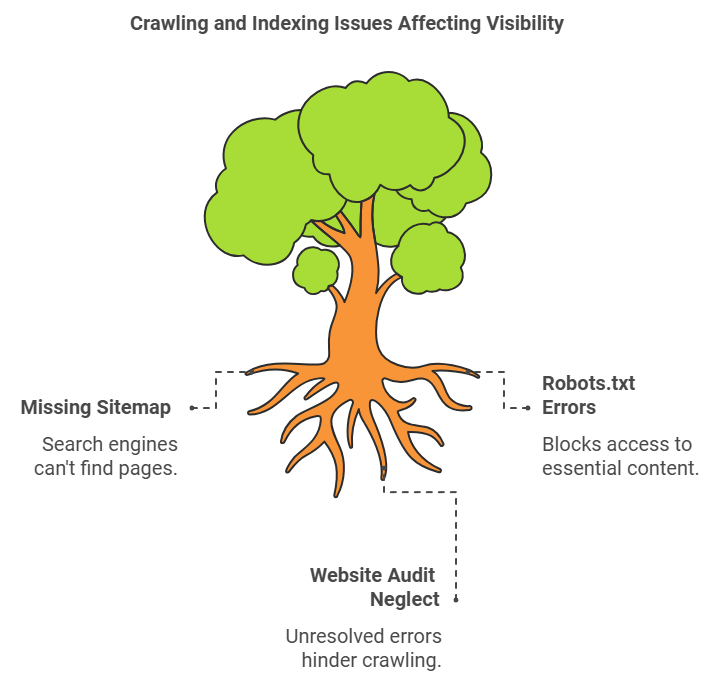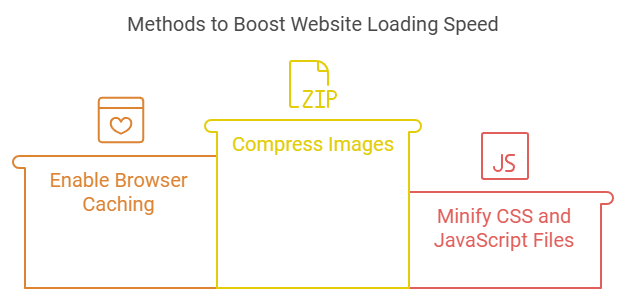Technical SEO forms the backbone of your website’s performance on search engines. It ensures your site is accessible, fast, and optimized for both users and search engines. Without proper technical SEO, even the best content may fail to rank well. In this guide, we will cover actionable technical SEO fixes to improve your website’s rankings and deliver immediate results.
Table of Contents
ToggleWhat Is Technical SEO and Why Is It Important?
Technical SEO refers to the behind-the-scenes elements of a website that improve its crawlability, indexability, and overall functionality. Search engines like Google rely on technical SEO factors to decide whether your site deserves to rank highly.
If your website has slow loading speeds, broken links, or indexing errors, search engines may struggle to understand or rank your pages effectively. Addressing these issues can result in quicker improvements to your rankings and user experience.
Technical SEO #1: Check and Fix Crawling and Indexing Issues
Why Crawling and Indexing Matter in Technical SEO
Search engines use bots to crawl and index your site. Crawling helps bots discover your pages, while indexing ensures those pages appear in search results. If either process fails, your content becomes invisible to users searching for it.

Steps to Resolve Crawling Problems
- Submit Your Sitemap
A sitemap provides a roadmap of your website to search engines. Use tools like Google Search Console to submit an accurate sitemap and ensure all your important pages are listed. - Fix Robots.txt Errors
Check your robots.txt file to ensure it does not block essential pages. Incorrect configurations in this file can prevent search engines from accessing your site. - Audit Your Website
Tools like Screaming Frog can scan your website for crawling issues, including 404 errors, duplicate content, and improperly linked pages.
Technical SEO #2: Improve Website Loading Speed
How Loading Speed Impacts SEO
Slow websites frustrate users and lead to higher bounce rates. Search engines prioritize faster-loading websites, making speed a critical technical SEO factor.

Ways to Boost Loading Speed
- Compress Images
Use tools like TinyPNG or ShortPixel to reduce image sizes without sacrificing quality. Smaller images load faster, improving overall speed. - Enable Browser Caching
Caching stores website data temporarily, allowing repeat visitors to load your site faster. Enable caching using plugins or by modifying your server settings. - Minify CSS and JavaScript Files
Remove unnecessary spaces and characters from CSS and JavaScript files. This reduces file sizes and speeds up loading times.
Technical SEO #4: Ensure Mobile-Friendliness
Why Mobile Optimization Is Key
More than half of all web traffic comes from mobile devices. A site that is not mobile-friendly risks losing a significant portion of its audience and ranking potential.
How to Check Mobile Usability
Use Google’s Mobile-Friendly Test tool to analyze your website. Address any errors, such as unreadable text, elements too close together, or improper scaling.
Technical SEO #5: Fix Broken Links
The Problem with Broken Links
Broken links disrupt user experience and waste crawl budget. Search engines see broken links as a sign of poor maintenance, which can negatively affect rankings.
How to Identify and Fix Them
- Use a Link Checker Tool
Tools like Ahrefs or Dead Link Checker can identify broken links across your site. - Replace or Remove the Link
Update broken links with correct URLs or remove them entirely. - Create Custom 404 Pages
A custom 404 page can guide users back to your main content if they encounter a broken link.
Technical SEO # 6: Optimize URL Structure
Why URL Structure Matters
Search engines prefer clean, descriptive URLs. A clear structure helps bots and users understand your content better.
Best Practices for URLs
- Use hyphens to separate words.
- Avoid special characters or numbers.
- Keep URLs short but descriptive.
For example, use /technical-seo-fixes instead of /p12345!seofixes.
Technical SEO #7: Implement Structured Data
What Is Structured Data?
Structured data is code that helps search engines understand your content more clearly. It can enhance your search results with rich snippets, such as ratings, FAQs, or recipes.

How to Add Structured Data
- Use schema markup generators to create the necessary code.
- Add the code to your website’s HTML.
- Test it using Google’s Rich Results Test tool.
Technical SEO #8: Secure Your Website with HTTPS
Why HTTPS Is Essential
An HTTPS-secured website builds trust and ensures data privacy for users. Google also considers HTTPS a ranking factor, meaning it directly impacts SEO.
How to Switch to HTTPS
- Obtain an SSL certificate from your hosting provider.
- Update your site’s internal links to use HTTPS.
- Redirect HTTP pages to their HTTPS versions.
Technical SEO #9: Monitor and Fix Duplicate Content
Why Duplicate Content Hurts SEO
Duplicate content confuses search engines about which page to rank. This can lead to lower rankings for all versions of the content.
How to Address Duplicate Content
- Use canonical tags to indicate the preferred version of a page.
- Redirect duplicate pages to the main page.
- Regularly audit your site to identify and resolve duplication issues.
Technical SEO #10: Regularly Update Your XML Sitemap
Why an Updated Sitemap Is Important
An XML sitemap helps search engines identify the structure of your website. Keeping it updated ensures all new and important pages are discoverable.
How to Maintain Your Sitemap
- Use plugins like Yoast SEO to generate an XML sitemap.
- Resubmit the sitemap to Google Search Console after significant site changes.
Technical SEO #11: Check for Crawl Budget Wastage
What Is Crawl Budget?
Crawl budget refers to the number of pages search engines crawl on your site within a given time. Wasting it on unnecessary pages can harm important ones.
How to Fix Crawl Budget Issues
- Use robots.txt to block irrelevant pages like admin panels.
- Remove or noindex low-value pages, such as tag archives.
- Consolidate thin content into richer, more comprehensive pages.
Technical SEO #12: Test and Fix Core Web Vitals
What Are Core Web Vitals?
Core Web Vitals measure loading speed, interactivity, and visual stability. They are critical factors for user experience and rankings.

How to Improve Them
- Largest Contentful Paint (LCP): Optimize images and fonts.
- First Input Delay (FID): Reduce script execution time.
- Cumulative Layout Shift (CLS): Set size attributes for all media.
Use Google PageSpeed Insights to monitor and fix these metrics.
Technical SEO #13: Audit Your Internal Linking Strategy
Why Internal Links Are Important
Internal links help search engines understand the structure of your site and pass link equity between pages.
How to Build a Strong Internal Linking Strategy
- Link to important pages from your homepage.
- Use descriptive anchor text.
- Avoid orphan pages by ensuring every page has at least one internal link.
Track Progress with Regular Audits
Why Audits Are Necessary
Technical SEO is not a one-time task. Regular audits help identify new issues and ensure ongoing performance improvements.
Best Tools for Technical SEO Audits
- Google Search Console
- SEMrush
- Ahrefs
Set a schedule to conduct a full audit every quarter.
Conclusion: Technical SEO For SEO
Improving technical SEO is a critical step for any website owner aiming for higher search engine rankings. By addressing issues like crawling, loading speed, mobile usability, and duplicate content, you can see immediate improvements in both user experience and SEO performance. Start with the basics, and use this guide as a roadmap to ensure your site is fully optimized.
FAQs
1. What is the first step in technical SEO?
Start with a crawl and indexability audit to ensure your pages are visible to search engines.
2. How often should I update my sitemap?
Update your sitemap whenever you add, remove, or modify significant pages on your website.
3. What are the best tools for monitoring technical SEO?
Popular tools include Google Search Console, Screaming Frog, and Ahrefs.
4. How do I fix slow loading times?
Optimize image sizes, enable caching, and reduce CSS and JavaScript file sizes.
5. Why is HTTPS important for SEO?
HTTPS secures your website and is a ranking factor for search engines like Google.








